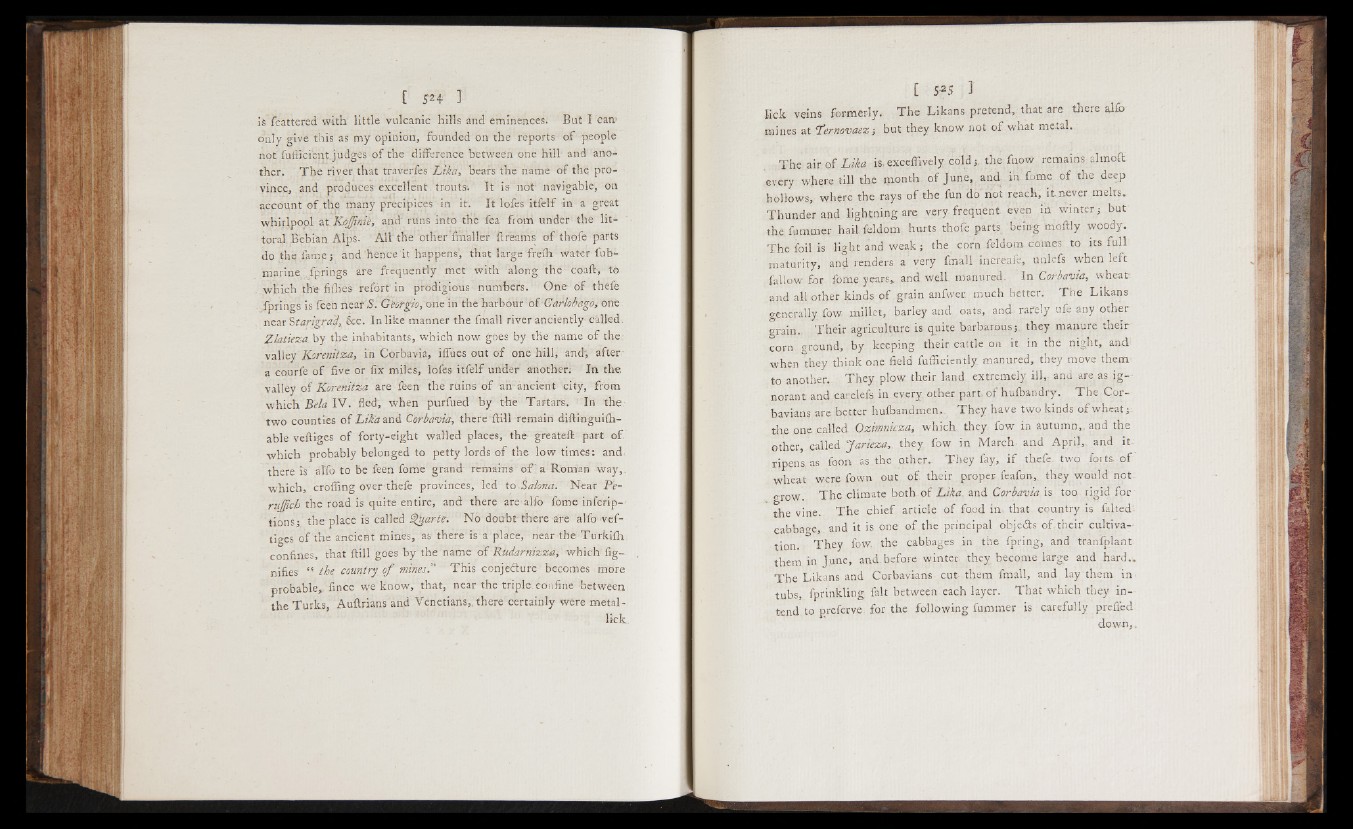
is fcattered with little vulcanic hills and eminences. But I catv
only give this as my opinion, founded on the reports of people
not fufficient judges of the difference between one hill and another.
The river that traverfes Lika, bears the name of the province,
and produces excellent trouts*. It is not* navigable, on
account o f the many precipices in it. It lofes itfelf in a great
whirlpool at Kojjini'e, and' runs into the fea from under the littoral
Bebian A lp i All'the otherJmaller Breams of thofe parts
do the fames and hence it happens', that large frefh water fub-
marine, . fprihgs are frequently met with along the coaft, to
which the fiflies refort in prodigious numbers. One of thefe
fprings is feen near 5 . Georgia, one in the harbour -of-Carlobagoi one
nearStarigra'd, &c. In like manner the fmall river anciently-called.
Zlatieza. by the inhabitants, which now goes by the name o f the
valley Korenilza, in Corbavia, iflues out o f one hill, and", after*
a courfe of five or fix miles, lofes itfelf under another: In the
valley o f Korenitza are feen the ruins o f 'ah ancient city, from
which Bela IV. fled; when purfued by the Tartars. In the
two counties of Lika and Corbavia, there Bill remain diflinguifh-
able vefliges o f forty-eight walled places, the greatefl part of.
which probably belonged to petty lords o f the low times: and
there is alfo to be feen fome grand* remains o f a Roman way,,
which, crofling over thefe provinces, led to Salona. Near Pe-
rujjicb the road is quite entire, and there are*alfo fome infcrip-*
tions; the place is called Htyartr. No doubt-there are alfovef-
tiges of the ancient mines, as there is a place, near the Turkifh
confines, that Bill goes by the name of Rudarnizza;, which fig-
nifies “ the country o f mines.” This conjecture becomes more
probable, fince we know, that, near the triple, confine between
the Turks Aufirians and Venetians,, there certainly were rnetallick
lick veins formerly. The Likans pretend, that are there alfb
mines at T’ernovaez; but they know not o f what metal.
The air o f Lika is. exceflively c o l d t he fnow remains almoft
every where till the month, o f June, and. in. ibme of the deep
hollows, where the rays of the fun do not reach, it never melts.
Thunder and lightning are very frequent even in winter; but
the fummer hailfeldom, hurts thofe parts being moflly woody.
The foil is light and weak; the corn feldom. comes to its full
maturity, and renders a very fmall increafe, unlefs when left
fallow for fome years, and well manured. In Corbavia, wheat*.
and all other kinds of grain anfwer much better; The Likans
generally fow millet, barley and. oats, and rarely uie any other
grain- Their agriculture is quite barbarous;, they manure their
corn ground, by keeping their, cattle on it in the night, and
when they think one field fufficiently manured, they move them
to another.. They plow their land extremely ill,- and are as.ignorant
and carelefs in every, other part, of hufl>andry. The Cor-
bavians are better huBiandmen.. They have two kinds o f wheat;,
the one called Ozimnicza, which, they, fow in autumn,, and the
other, called Jarieza,, they fow in March, and April, and it.
ripens, as foon as the other. They fay, i f thefe. two forts- o f
wheat were fown out o f their proper feafon, they would not
grow. The climate both of Lika, and Corbavia is too rigid for
the vine. The chief article o f food im that country is falted
cabbage, and it is one of the principal obje&s of. their cultivation.
They fow. the cabbages in the fpring, and tranfplant
them in June, and before winter- they become large and hard..
The Likans and Corbavians cut- them fmall, and lay them in.
tubs, fprinkling fait between each layer. That which they intend
to preferve for the following fummer is carefully prefled
down,,